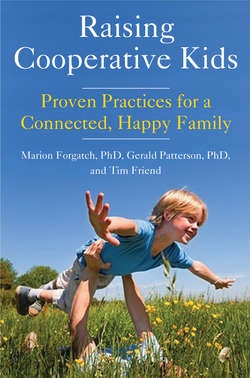Читать книгу Raising Cooperative Kids - Marion S. Forgatch - Страница 8
На сайте Литреса книга снята с продажи.
Our Methods
ОглавлениеTo make sure that our strategies work, we tested them using what is called randomized controlled trials. That is the same rigorous approach the medical profession uses to determine whether or not a drug or procedure is effective. In our trials, we randomly assigned some parents to receive our techniques while others were assigned to receive treatment as usual or no treatment. We tested families before and after the intervention period, and for follow-up periods from months to years. Then we compared the outcomes for the different randomized groups. This is the way to be objective and discover whether a treatment or technique works. You can learn about our studies at www.isii.net or at www.oslc.org.
The success of our evidence-based parenting methods has attracted attention worldwide. With demand for our parenting approach increasing rapidly, I established Implementation Sciences International, Inc. (ISII) in 2001 to separate the ongoing research at our research center, called the Oregon Social Learning Center (OSLC), from the tasks of training practitioners in our methods, writing manuals for practitioners and parents, and handling the logistics for launching our ever-growing programs. Today, demand is greater than we can meet, so we decided to write this book to make our techniques available to as many parents as possible.
Because we have carefully tested our methods and subjected our findings to independent review by other scientists, you can be confident that they work. Our group at OSLC has published more than 1,000 papers in peer-reviewed professional journals and contributed dozens of chapters in academic books. Jerry's published work on “coercion theory” and parenting has been cited more than 50,000 times by other scientists. The fields of psychology, sociology, and criminology have adopted Jerry's coercion theory as an underlying explanation for children's behavior problems.
Studies show that the parenting strategies we recommend are successful in promoting children's healthy adjustment and preventing problems from developing. The same techniques also reduce or eliminate problems that are already present.
We wrote this book to share what we have learned so you can create the family you will love to love. This book is a journey we take together. Be sure to follow our road map through each chapter and don't jump ahead. The ground you cover in one chapter sets you up to find your way through the next. You will enhance your success at building new skills if you do the exercises in the order presented, chapter by chapter. Each exercise builds on the previous one; in the end, all the skills link together to create strong, confident parents.
Each chapter ends with a practice assignment that gives you the opportunity to try our strategies and adjust them to fit your values and goals as parents, as well as your children's temperament, age, developmental stage, personal interests, and talents. In some chapters, we have added a section called What Do Parents Say? That section provides comments made by real parents—some praising the parenting strategies, others raising questions about how to use them.
Family living is often like an intricate dance in which family members learn to move in synchrony with each other. We describe this complicated choreography, then use family scenarios to help you tailor our strategies to the needs of you and your children. Because all families get out of synch and sometimes step on each other's toes, we show families experiencing problems based on actual circumstances we have observed (and experienced ourselves) over the years. Then we “rewind” the situation and play out the scenario again, following the techniques introduced in that chapter.
Because today's families are so diverse, we describe different family structures (two-parent, single-parent, and blended families) with children of differing ages and genders. As you read the scenarios, try to imagine your family in the situation. After you have tried out a strategy, you can adjust it to suit your family members' individual needs and circumstances. For example, the kinds of praise you use to encourage your two-year-old will differ from the way you praise your twelve-year-old.
While our techniques are appropriate for children of all ages, this book will be most helpful for parents of children from toddlerhood through the tween years, when children are most open to learning from you. You will probably need some additional approaches to address the issues that arise during the teen years. Our books Parents and Adolescents, Living Together, Part 1 and Part 2 (Patterson & Forgatch; Forgatch & Patterson) are good resources for this.
